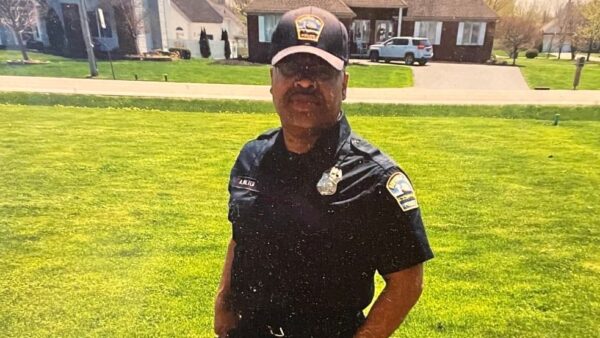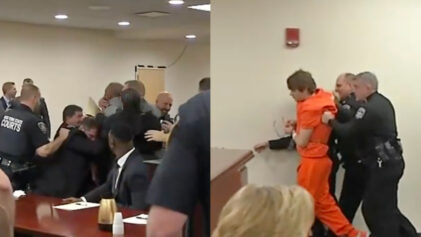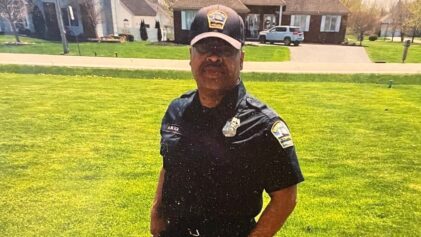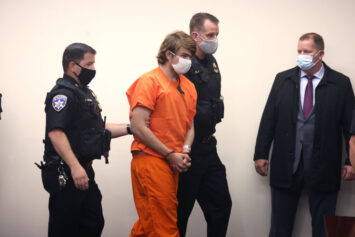The gunman who is accused of shooting 13 people, killing 10, in a Buffalo, New York, grocery store on Saturday had plans to carry on the racial carnage in the Black neighborhood, according to reports.
Authorities said they found evidence that shows that if Payton Gendron had made it out of the Tops Friendly Markets parking lot, he would’ve continued his shooting rampage on the streets and possibly in another store.

“There is ‘some documentation’ the suspect had plans possibly for a shooting at “another large superstore,” Buffalo Police Commissioner Joseph Gramaglia said. “He was going to get in his car and continue to drive down Jefferson Avenue and continue doing the same thing.”
The FBI and local authorities are still unraveling the details behind the mass shooting. Gendron faces state felony murder charges, but local authorities say they plan to pursue more. The FBI is investigating the case as a hate crime. Gramaglia said they sought warrants for the suspect’s computers, phones, home and vehicle.
Gendron joked about committing a murder-suicide while doing a class project about post-graduation plans in high school last year, according to reports. He was taken to a hospital for a mental evaluation, which reportedly lasted a day and a half. The threat was not racially motivated, according to reports.
Gendron wrote in his 108-page manifesto that he picked up white supremacy while being bored during the COVID-19 lockdown.
When authorities responded to the shooting at the Tops store on Saturday, the shooter had a “gun to his own head.” Police officers talked him down before he was arrested, reports show.
Many believe law enforcement’s approach was too soft, and a Black suspect would have been met with gunfire. Gramaglia rebutted the claims by pointing out that Gendron pointed a gun at himself and not police, The New York Times reports.
“We’re not looking to shoot anyone,” he said.
Gendron is on suicide watch and segregated from the general population at the Erie County Holding Center, officials said. He pleaded not guilty to the felony murder charge on Saturday and faces life in prison without parole. He is being held without bond and scheduled to return to court in four days.
License plate reader information shows the suspect was in the Masten Park neighborhood the day before the shooting, three-and-half hours away from his home in Conklin, New York.
Two months before he reportedly was confronted by a security guard while he scanned the store. He chose the area because it “has the highest Black percentage that is close enough to where I live,” according to his online manifesto detailing his plans and motive for the attack.
Residents of the Buffalo neighborhood, which is 78 percent Black, said they are angry and shaken by the racial massacre.
Buffalo Mayor Byron Brown said the victims “were going about their daily lives, left in the morning and had every expectation that they’d be home at night with their families.”
“Many of us stood shoulder to shoulder yesterday in pain, like all of us are in pain, dealing with the aftermath of this horrible, racist, violent attack on our community,” he said during a church service on Sunday.
Gendron, 18, reportedly opened fire on shoppers and in and outside the store around 2:30 p.m. in the “calculated” attack on Saturday. He had a camera affixed to a helmet on his head and the N-word scribbled in white on his altered assault rifle. He broadcasted the shooting on a live-streaming platform.
In his manifesto, the mass shooter wrote that he wanted to kill as many Black people as possible, inspired by the theory that Black people, Jews, immigrants, and other minorities would replace (Christian) white people. The “replacement theory” ideology closely tracks rhetoric spewed by Fox News TV personality Tucker Carlson and some GOP lawmakers.
“This is someone who has hate in their heart, soul and mind,” Gramaglia said.
Aaron Salter Jr., 55, store security guard and a former Buffalo police officer, tried to take out the assailant, but Salter’s bullets could not penetrate Gendron’s military-style body armor, reports show. The gunman killed him. Gramaglia said Salter’s actions probably saved some lives, and he is being hailed a hero.

Salter’s family and friends said they are trying to cope with the news of the man’s death.
“Today is a shock,” his son, Aaron Salter III, told The Daily Beast on Saturday. “I’m pretty sure he saved some lives today. He’s a hero.”
The father of three retired in 2018 after serving as an officer since the 1980s. He escaped being shot in 1996 when a burglary suspect pointed a loaded 12-gauge shotgun in his face, a Buffalo News report shows.
“My first reaction was to duck,” Salter told reporters. “I don’t enjoy looking down the barrel of a shotgun, and if it hadn’t been for my partner shooting first, it would have been a golden opportunity to shoot us. My partner probably saved us.”
Salter worked in the traffic division, where he would be assigned to major events later in his career. He also worked as a substitute teacher and converted his garage into a lab to work on his formula for a hydro-fueled car engine. Salter started a company called AWS Hydrogen Technologies after he retired.
“Aaron is one of the most intelligent individuals that I’ve ever crossed paths with. Today hurts,” Roscoe C. Henderson, III, a friend of Salter’s, wrote on social media.
Ruth Whitfield, an 88-year-old grandmother of eight, also died in the attack. Her family described Whitfield as a caring mother and wife dedicated to her family. She had just finished her daily routine of caring for her elderly husband in a nursing home when she stopped by the Tops store close to her home, her family said.
“I went to the scene and…I saw there was a car of the same color as hers in the handicapped parking, which is where she would have parked,” Ruth’s son, Garnell Whitfield Jr. said. “I’m not good. Not good. My mom was murdered. How am I supposed to feel? My mom was murdered.”
Celestine Chaney, 65, died getting strawberries to make shortcakes, and Andre Mackneil, 53, was picking up a birthday cake for his grandson, reports show. Roberta Drury, 32, was getting food for dinner, and Geraldine Talley, 62, was doing her regular grocery shopping when she was killed.
“She’s sweet, sweet, you know, the life of the party,” Drury’s niece Lakesha Chapman told CNN. “She was the person who always put our family reunion together. She was an avid baker … mother of two beautiful children.”
Heyward Patterson was fatally shot while helping put groceries into another shopper’s car. He was a beloved church deacon who was always willing to help others, according to his wife. He volunteered to clean the church every Saturday and would often feed the homeless.
“He would give the shirt off his back,” Tirzah Patterson said.
Pearl Young, 77, who was also killed Saturday, runs a food pantry in the neighborhood. Katherine Massey, 72, was a civil rights and education advocate. Margus D. Morrison, 52, leaves behind three children.
Christopher Braden, 55; Zaire Goodman, 20; and Jennifer Warrington, 50, were also shot in the massacre.
The Tops store massacre is also an economic attack, residents said. With the neighborhood’s only full-service grocery store closed during the investigation, people have few resources left to buy food. Residents had rallied for over a decade before the store was opened in 2003.
New York Gov. Kathy Hochul has allocated $2.8 million for the victims and their families, and Tops Friendly has offered residents free food and transportation.

Residents called out politicians for “pandering” to a community that had been long forgotten before the shooting.
“We don’t want to be protected after the fact,” said Marlene Brown, 58, a Black resident. “We want to be protected and treated like we matter without it taking a white supremacist shooting up our community.”
“Time and time again, they’ve shown nobody cares about us here. It’s a pattern,” she said.
Although the assailant was not from Buffalo, Black residents said they faced racism for decades in a city that has been ranked one of the most segregated places in the U.S.
A highway two blocks from the scene of the deadly shooting is a separation tool reportedly used to divide white and Black residents.
According to reports, the construction of the Kensington Expressway in the 1950s and 1960s left Black residents in a “downward trend” for the last 30 years ago.
“The pain is in our DNA at this point,” said Earlene Patterson, 64, who bought milk and other food from the Tops grocery store days before the attack. “It’s in my great-grandfather, my father. It’s in me.”


